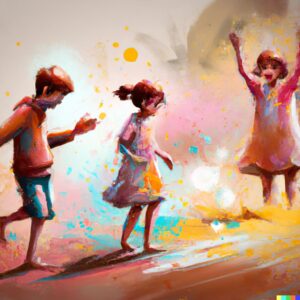Navratri, a widely celebrated Hindu festival, is a vibrant and joyous occasion that spans nine nights and ten days. The word ‘Navratri’ itself is derived from ‘Nav’ meaning nine and ‘Ratri’ meaning night. This festival is devoted to the worship of the divine feminine in the form of Goddess Durga. It holds immense cultural and religious significance, and it’s celebrated with grandeur and enthusiasm throughout India and by Hindus worldwide. Here are 10 points on Navratri to help you understand the essence of Navratri.

10 Points on Navratri
- Worship of Goddess Durga:
Navratri is dedicated to the worship of Goddess Durga, who is the epitome of divine power, courage, and victory over evil. The festival celebrates her various incarnations, and the ninth day, also known as Maha Navami, is when she is revered in all her glory. - Nine Forms of the Goddess:
Each of the nine nights is dedicated to one of the nine incarnations of Durga, namely Shailaputri, Brahmacharini, Chandraghanta, Kushmanda, Skandamata, Katyayani, Kalaratri, Mahagauri, and Siddhidatri. These forms represent the different aspects of the divine femininity. - The Battle of Good Over Evil:
Navratri symbolizes the victory of good over evil. It is believed that Goddess Durga fought the demon Mahishasura for nine days and nights, ultimately defeating him on the tenth day, which is celebrated as Dussehra. - Fasting and Purity:
During Navratri, many people observe fasts to purify their body and soul. They abstain from consuming non-vegetarian food, alcohol, and certain grains and focus on a diet of fruits, vegetables, and dairy products. - Dandiya and Garba Dance:
In the western regions of India, especially in Gujarat, Dandiya and Garba dances are an integral part of Navratri celebrations. These energetic and colorful dances involve the use of wooden sticks and traditional costumes, creating a joyful atmosphere. - Colorful Attire:
Dressing in vibrant and traditional attire is a significant aspect of Navratri. Women often wear ghagra-cholis, lehengas, and adorn themselves with jewelry, while men opt for kurta-pyjamas or dhotis. The bright colors symbolize the festive spirit. - Divine Offerings:
Devotees offer flowers, fruits, and incense to the Goddess during prayers. The ‘arti,’ a ritual of waving a lamp in front of the deity, is a common practice. Many also offer ‘bhog’ or prasad, which includes sweets and other vegetarian dishes. - Cultural Diversity:
Navratri is celebrated with varying customs and traditions across India. While Gujarat and Rajasthan are known for their exuberant dance forms, North India hosts Ramlila performances during this time. In West Bengal, Durga Puja takes precedence during Navratri. - Social Gatherings:
Navratri is not just a religious festival; it’s also a time for social bonding and enjoyment. Families and friends come together to participate in cultural events, play music, and celebrate the festivities with great enthusiasm. - The Victory of Light:
The essence of Navratri is the triumph of light over darkness, knowledge over ignorance, and hope over despair. The festival serves as a reminder that good deeds, righteousness, and the power of the divine always prevail.
Navratri is a festival that encapsulates the rich cultural and religious diversity of India. It symbolizes the enduring spirit of hope, faith, and the victory of good over evil. Whether you partake in the religious rituals, dance to the lively beats of Garba, or simply bask in the joyous ambiance, Navratri is a time to celebrate life, spirituality, and the triumph of positivity. It is a beautiful reminder of the power of the divine feminine and the strength it represents.





